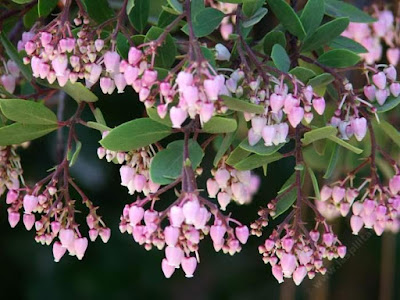 |
| Arctostaphylos, Baby Bear Manzanita Bush, Photo Credit: Las Pilitas Nursery, Santa Margarita, California |
The lovely Manzanita (Arctostaphylos species) with its delicate pink urn-shaped flowers in spring hardly seems like a tough, fire-resistant plant. But in fact this small tree is a survivor. If a wildfire were to come through your garden or the hillsides behind your house, you would be glad Manzanita was planted there.
Manzanita has a deep crimson bark that is very dense, strong and heavy. In a fire, the wood would be slow to burn, but burn it would. Still, the plant would not burn to the ground; instead, a basal stump would remain for new growth to branch out in the next rains.
Manzanita is a California plant, native to chaparral and soft-scrub ecosystemsm of areas such as the coastal Santa Monica Mtns. There are many varieties of Manzanita, and they can be found growing wild from San Diego north to Carmel.
Not all Manzanitas are as equal, when it comes to fire resistance. Small bushes, in general, are best. One of the recommended Manzanitas for fire resistance is this one: Arctostaphylos Baby Bear Manzanita Bush. Baby Bear grows to about 6ft tall and 6ft wide. It is drought-tolerant in Coastal California.
 |
| Anna's Hummingbird on Arctostaphylos, Baby Bear Manzanita Bush Photo Credit: Las Pilitas Nursery, Santa Margarita, California |
Manzanita can fit into any size garden. Each plant has its own unique shape, making it a work of art in the garden. Manzanita come in many shapes and sizes, from trees and bushes to groundcovers! They make graceful specimen plants or can be pruned into hedges.
For myself, I love walking through the fog and seeing Manzanita sentinels standing out along the pathways~ May they always grace the coast of California.
You can read more of this Series, starting with: Gardening in the Line of Fire
.
No comments:
Post a Comment